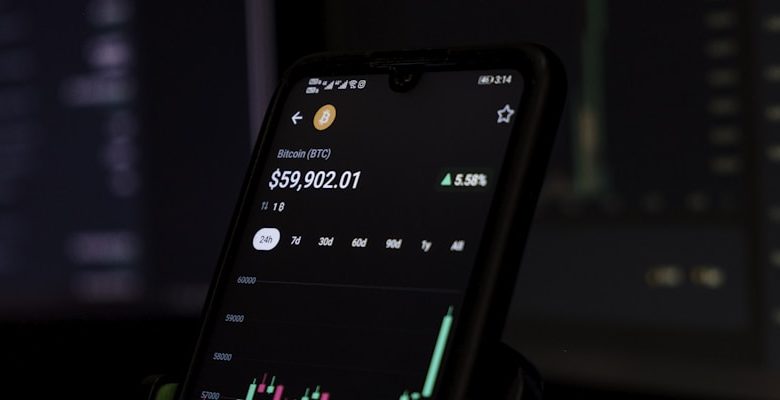The Impact of Inflation on Cryptocurrency Prices

- The Relationship Between Inflation and Cryptocurrency Prices
- How Inflation Affects the Value of Cryptocurrencies
- The Role of Inflation in Shaping Cryptocurrency Markets
- Analyzing the Impact of Inflation on Cryptocurrency Price Volatility
- Strategies for Investors to Navigate Inflation-Driven Cryptocurrency Price Fluctuations
- Exploring the Connection Between Inflation Rates and Cryptocurrency Performance
The Relationship Between Inflation and Cryptocurrency Prices
When it comes to understanding the impact of inflation on cryptocurrency prices, it is important to consider the relationship between the two. Inflation, which refers to the general increase in prices of goods and services over time, can have a significant effect on the value of cryptocurrencies.
One key factor to consider is that inflation can erode the purchasing power of traditional fiat currencies, such as the US dollar or Euro. As the value of these fiat currencies decreases, investors may turn to alternative stores of value, such as cryptocurrencies, to protect their wealth.
Additionally, inflation can lead to an increase in the overall demand for cryptocurrencies as people look for ways to hedge against inflation. This surge in demand can drive up the prices of cryptocurrencies, making them a more attractive investment option in times of economic uncertainty.
It is also worth noting that some cryptocurrencies, such as Bitcoin, are designed to have a limited supply. This scarcity can help protect against the effects of inflation and ensure that the value of the cryptocurrency remains relatively stable over time.
How Inflation Affects the Value of Cryptocurrencies
When it comes to cryptocurrencies, inflation can have a significant impact on their value. Unlike traditional fiat currencies that are subject to inflation due to government policies and economic factors, cryptocurrencies operate on a decentralized system that is not influenced by such factors. However, inflation can still affect the value of cryptocurrencies in various ways.
One way inflation can affect the value of cryptocurrencies is through the increase in supply. As more units of a cryptocurrency are created, the value of existing units can decrease due to inflation. This can lead to a decrease in the purchasing power of the cryptocurrency, making it less valuable compared to other assets.
Another way inflation can impact the value of cryptocurrencies is through investor sentiment. In times of high inflation, investors may flock to cryptocurrencies as a hedge against inflation, driving up demand and subsequently the value of the cryptocurrency. Conversely, in times of low inflation, investors may be less inclined to invest in cryptocurrencies, leading to a decrease in value.
Overall, it is important for investors to consider the impact of inflation on the value of cryptocurrencies when making investment decisions. By staying informed about economic trends and developments, investors can better navigate the volatile cryptocurrency market and make informed decisions about their investments.
The Role of Inflation in Shaping Cryptocurrency Markets
Inflation plays a crucial role in shaping cryptocurrency markets. The impact of inflation on cryptocurrency prices is significant, as it affects the value of digital assets and the overall market sentiment. Understanding how inflation influences the cryptocurrency market can help investors make informed decisions and navigate the volatile nature of this emerging asset class.
One of the key ways in which inflation impacts cryptocurrency prices is through the creation of new coins. When a cryptocurrency has a high inflation rate, it means that new coins are being introduced into circulation at a rapid pace. This can lead to an oversupply of coins, which can drive down prices as demand fails to keep up with supply.
Furthermore, inflation can also erode the purchasing power of a cryptocurrency. As the value of a digital asset decreases over time due to inflation, holders may find that their coins are worth less than they initially invested. This can lead to a decrease in demand for the cryptocurrency, further driving down prices.
It is important for investors to consider the impact of inflation when evaluating the potential risks and rewards of investing in cryptocurrencies. By understanding how inflation can shape cryptocurrency markets, investors can make more informed decisions and better navigate the ever-changing landscape of digital assets.
Analyzing the Impact of Inflation on Cryptocurrency Price Volatility
When analyzing the impact of inflation on cryptocurrency price volatility, it is important to consider how changes in the overall purchasing power of fiat currencies can affect the value of digital assets. Inflation refers to the general increase in prices of goods and services over time, leading to a decrease in the purchasing power of a currency. This can have a direct impact on the value of cryptocurrencies, as investors may flock to digital assets as a hedge against inflation.
One of the key ways in which inflation can influence cryptocurrency prices is through the perception of digital assets as a store of value. In times of high inflation, traditional fiat currencies may lose value rapidly, leading investors to seek alternative stores of value such as cryptocurrencies. This increased demand can drive up the price of digital assets, leading to greater price volatility in the cryptocurrency market.
Additionally, inflation can also impact the supply dynamics of cryptocurrencies. Many digital assets have a fixed supply cap, meaning that new coins cannot be created beyond a certain limit. In contrast, fiat currencies can be printed endlessly by central banks, leading to inflation. As the supply of fiat currencies increases, the purchasing power of each unit decreases, leading to a decrease in value. This can drive investors towards cryptocurrencies with limited supplies, further increasing their demand and price.
Strategies for Investors to Navigate Inflation-Driven Cryptocurrency Price Fluctuations
Investors looking to navigate inflation-driven fluctuations in cryptocurrency prices can employ various strategies to mitigate risks and capitalize on opportunities. One approach is to diversify their investment portfolio by spreading their funds across different types of cryptocurrencies, as well as traditional assets such as stocks and bonds. This can help offset potential losses in one asset class with gains in another, reducing overall volatility.
Another strategy is to keep a close eye on market trends and news related to inflation, as these factors can have a significant impact on cryptocurrency prices. By staying informed and adapting their investment decisions accordingly, investors can position themselves to take advantage of shifting market conditions.
Additionally, investors may consider using tools such as stop-loss orders to automatically sell their assets if prices drop below a certain threshold. This can help protect against sudden price drops and limit potential losses.
Furthermore, engaging in thorough research and due diligence before making investment decisions is crucial. Understanding the underlying technology, market dynamics, and regulatory environment of cryptocurrencies can help investors make more informed choices and reduce risks.
Overall, by employing a combination of diversification, market monitoring, risk management tools, and informed decision-making, investors can navigate inflation-driven cryptocurrency price fluctuations with greater confidence and potentially achieve more favorable outcomes in the long run.
Exploring the Connection Between Inflation Rates and Cryptocurrency Performance
Cryptocurrencies have become an increasingly popular investment option due to their potential to provide returns that are not correlated with traditional financial markets. One interesting aspect to explore is the connection between inflation rates and the performance of these digital assets.
Inflation rates can have a significant impact on the value of fiat currencies, leading investors to seek alternative stores of value like cryptocurrencies. When inflation rates rise, the purchasing power of traditional currencies decreases, which can drive investors towards digital assets as a hedge against inflation.
Historically, cryptocurrencies like Bitcoin have been touted as “digital gold” due to their limited supply and decentralized nature. This has led some investors to view them as a potential hedge against inflation, similar to how gold has been used for centuries.
It is important to note that the relationship between inflation rates and cryptocurrency performance is not always straightforward. Factors such as market sentiment, regulatory developments, and macroeconomic conditions can also influence the prices of digital assets.
Overall, exploring the connection between inflation rates and cryptocurrency performance can provide valuable insights for investors looking to diversify their portfolios and hedge against inflation risks. By understanding how these factors interact, investors can make more informed decisions when it comes to incorporating cryptocurrencies into their investment strategy.



